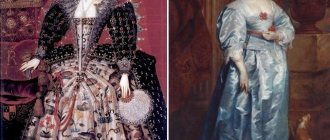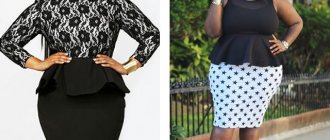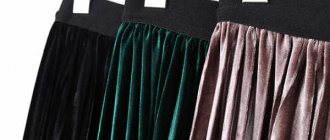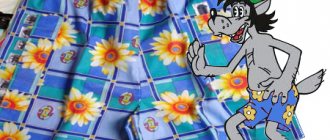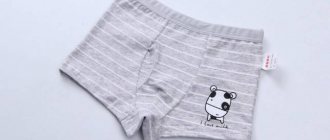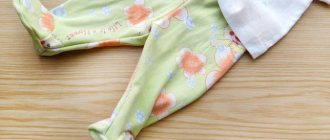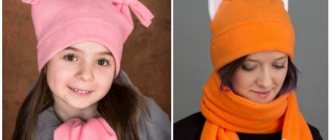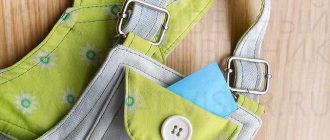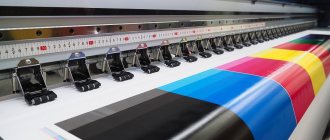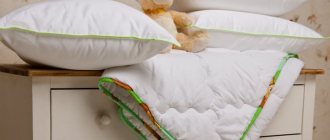A turtleneck is a basic item in the wardrobe of not only adults, but also children. With this element you can keep warm by wearing it under a cardigan, shirt or sweater. Turtlenecks look beautiful worn under a vest or overalls. Women often wear them with a sundress. This product is comfortable and practical to wear. In the off-season and changeable weather, it is more difficult to catch a cold in your throat in a turtleneck, because it is covered with a high, tight-fitting neckline. Sewing a turtleneck with your own hands is not difficult.
Turtleneck pattern
In order to draw a pattern, you will need measurements:
- Bust
- Waist circumference
- Shoulder length
- Neck circumference
- Back length to waist (from the 7th vertebra to the waist line)
- Hip girth
- Wrist circumference
- The length of the sleeve
- Length of the product
The height of the stand is arbitrary.
The knit turtleneck pattern below is suitable for sizes 48-50. (Or build to your own standards). If a smaller size is needed, you need to reduce the armhole line by 0.5 cm, and the side line and sleeve by 1 cm on each side.
You will need a rectangle for the neck separately. It is 0.5-2 cm less than the length of the neck. This must be done so that the neck is well covered. The width is double, since the part will be folded in half.
Allowances - they are not necessary if the fabric stretches well.
Linen shelf
It stores underwear - panties, T-shirts, tops, T-shirts, thin pajamas and nighties. They are sewn mainly from natural cotton or blended fabrics.
The surface density of knitwear for cotton is from 145 to 180 g/m2.
KULIRNAYA STINKIN or KULIRKA (100% cotton) is the thinnest fabric that is produced on a circular knitting machine like a stocking, so the material has no edges. In addition to clothes for adults, the fabric is intended for sewing rompers, vests and suits for babies.
Peculiarities:
- has a front side - a smooth surface made from knit stitches, and a back side - a rough side made from purl loops;
- stretchability only in weft;
- has average creasing properties;
- One of the disadvantages is curling along the width of the fabric and dropping loops, that is, the knitting easily unravels and “arrows” are formed.
Available in three types:
OPEN END SILENCER (OE, open end) – the cheapest, made from short cotton fibers. The fabric turns out loose and with soft fluff. Sometimes manufacturers increase the comb on purpose.
RING – made of medium length cotton fibers. The pile is smaller than in the case of open end, the thickness of the canvas is uniform.
PENYE JOINT – for knitting, threads made from long cotton fibers with a dense twist are used, which provides the knitwear with smoothness and increased wear resistance. Peñe is the highest grade of knitwear.
With the addition of synthetics to cotton underwear, ironing will no longer be needed, and the material will also increase in softness and elasticity. The most common from this group of knitwear are:
COTTON CUT - a Western analogue of cotton kulirka with the addition of elastane from 5 to 8%;
SUPREM is also a traditional cooler with the addition of lycra - from 5 to 8%. With an increase in density, this fabric can already belong to the dress group.
GIPEL - it is also called a knitted harvester. The relief structure is obtained from the stockinette stitch due to constricting transverse threads that do not form a loop. The yarn, as a rule, has up to 10% synthetic composition - lycra or elastane, which increases the stretchability of the entire fabric.
The properties of this knitwear are the same as knitwear, the only difference is that it has less unraveling ability, which makes cutting and processing easier. The surface density of the canvas can reach 200 g/m2. However, hypel is used exclusively for sewing children's underwear up to 3 years old.
Important! Elastane - acts as a name only in Europe; in North America, the word “spandex” is used to designate identical fibers.
MULTIRIPE OR LINEN RIBANA - used as a finishing for processing necklines, armholes, open sections of the above fabrics. Slightly less often, tight-fitting T-shirts or tops are made from multi-rip cotton. Weave - eraser 1*1, like an English elastic, one purl loop, one knit stitch.
Peculiarities:
- high transverse extensibility;
- wear resistance;
- does not bloom;
- does not shrink after washing.
RIBANA-AZHUR is a type of multirip with charming holes, which are obtained by skipping one or several loops while knitting the fabric.
Applicable:
- 100% cotton, as well as with viscose additives - T-shirts, light pajamas and nightgowns;
- with the addition of 5% elastane - for clothes for newborns;
- with polyester up to 30% - for men's and women's elastic swimming trunks and panties;
- as finishing for other knitted fabrics.
Cutting turtleneck details and allowances
The pattern is built without seam allowances, so after downloading the pattern for the turtleneck parts, you need to copy it onto another paper to add allowances.
The width of the allowances depends on the stitch width of your equipment, here you act independently. Cut out the parts in the quantity indicated on the pattern details.
Do not duplicate.
How to make a turtleneck pattern
The pattern of this convenient model is elementary and uncomplicated. Many craftswomen cut without it, making the necessary calculations and markings on the fabric. If you plan to repeatedly sew similar products for yourself or for a child in the future, then it is more convenient to have a paper pattern on hand. Then you won’t have to do calculations and drawings every time.
What measurements are needed
To build a children's or women's turtleneck, you will need to take the appropriate measurements.
- Semi-circumferences: waist, chest, hips.
- Circumferences: neck, wrist.
- Height: hips, barrel.
- Length: product, shoulder, back to waist, sleeves.
- Sleeve width (forearm circumference).
Creating a pattern for a women's turtleneck
The pattern of the back and front front is built inside a rectangle in a mirror image.
Back and front
- First you need to identify all the main levels. Measure 2 cm down from the top and draw a horizontal line. This will be the shoulder line.
- Measure down 20 cm from it, this will be the level of the armhole.
- Again, from this line you need to set aside the length of the back to the waist (approximately 42 cm) and draw a waist line.
- From the waist down we set aside the height of the hips, this will be the level of the hips.
Important! The hip line can match the length of the product or be higher. It all comes down to personal preference as to where you want your turtleneck to end.
- From the waist up, we set aside the height of the barrel minus 2–2.5 cm (approximately 22-2 = 20 cm) for the freedom of the armhole, and draw a horizontal line for the armhole.
- At chest level, along the back and the shelf from the folds, measure the half-circumference of the chest, divided into two plus allowances.
- We do the same with the waist and hips. Allowances should be 2–3 cm for a loose fit.
- Connect all the resulting points smoothly. This will create the side line of the front and back. (The diagram shows a sharper transition; this is not necessary for the pattern).
- From the top point on the left and right of the rectangle you need to mark the neck, measure 6 cm.
- Place 2 cm down on the back and 5 cm on the front. Connect the dots with smooth lines.
- Now you need to measure the shoulder measurement from the neckline to the sides at 12 cm and mark it with a dot.
- From there, lower the shoulder 1.5 cm down and connect it to the neck.
- From the shoulder point, draw a perpendicular down to the armhole level and connect to the side line. The result is an armhole line, but you need to mark this line more smoothly by cutting off a right angle.
Construction of the sleeve
- Draw a vertical line in the middle of the sheet. From the top edge we set the height of the rim down. It can be calculated using the formula: divide the length of the armhole by 3.14 . The armhole can be measured with a measuring tape (back + front). It is approximately 47 cm, so the height of the rim is 15 cm (47/3.14).
- Down from the very top, measure the height of the sleeve 15 cm and the length of the sleeve 65 cm. From the point of height of the sleeve, you need to measure to the left and right the width of the sleeve, divided by 2. Design the sleeve with a smooth line.
- Measure your wrist below. For example, if it is 18 cm, then 4.5 cm to the left and to the right. Connect the bottom and top of the sleeve.
Collar
The collar is cut in the form of a rectangle with sides 18 and 38 cm. Where 18 is the height multiplied by 2, and 38 is the neck circumference.
LiveInternetLiveInternet
—Quote book
Planners, weekly planners, notepads. Templates for design. Plan your day, week, etc.
Planners, weekly planners, notepads. Templates for design. Plan your day, week, etc.
Cookies "Nuts" - a favorite treat Cookies "Nuts".
“Magic oil” will help with stretch marks and sagging skin. “Magic oil” will help with stretch marks and sagging skin.
6 simple steps on how to buy medicines cheaper About the fact that in all pharmacies there are creatures for medicines.
—Tags
—Links
—Categories
- SEWING. FROM JEANS (56)
- AUTO (49)
- Cottage, garden (26)
- SEWING. FOR THE BATHROOM AND TOILET. (14)
- COMPUTER (7)
- COOKING. MULTICOOKER (3)
- HOLIDAY. ST. DAY VALENTINE (2)
- HAIRSTYLES (1)
- RELIGIOUS (1)
- Everything for LI.RU (39)
- KIDS (99)
- Toys (44)
- Games (14)
- Rug (11)
- Blanket, bedspread (12)
- Crafts from boxes (9)
- Educational (32)
- Speech development (1)
- HOME HOUSEHOLD TIPS (47)
- INTERIOR, CONSTRUCTION, REPAIR (52)
- BOXES, CASKETS (68)
- BEAUTY. HAIR (30)
- BEAUTY. HOME COSMETICS (35)
- Oils (22)
- SPA (7)
- BEAUTY. FACE (172)
- Eyes (33)
- Oily skin (5)
- Combination skin (3)
- Cream (32)
- Lotion (9)
- Masks (85)
- Oils (7)
- Wrinkles (62)
- Normal skin (1)
- Cleansing (5)
- Pigmentation, freckles (10)
- Seasonal care (4)
- Scrub (12)
- Dry skin (9)
- Tonic (5)
- BEAUTY. LEGS (9)
- BEAUTY. HANDS (9)
- BEAUTY. BODY (21)
- BEAUTY. NECK (7)
- COOKING. Pancakes, pancakes (4)
- COOKING. DESSERT (25)
- COOKING. BLANKS (41)
- COOKING. SNACK (29)
- Tartlets (7)
- COOKING. FROM COOK (0)
- COOKING. OILS, SAUCES, SEASONINGS. (4)
- COOKING. MEAT (14)
- COOKING. DRINKS (6)
- COOKING. PIES. PIZZA (22)
- COOKING. HOLIDAY (21)
- COOKING. BIRD (10)
- COOKING. FISH (2)
- COOKING. SALADS (18)
- COOKING. TIPS (7)
- COOKING. SOUPS (0)
- COOKING. DOUGH (11)
- COOKING. CAKES, PASTRY, COOKIES, Muffins. (16)
- COOKING. DISH DECORATIONS (18)
- MY WORKS (8)
- TRADITIONAL MEDICINE (103)
- Allergies (1)
- Skin diseases (25)
- Baths (1)
- Respiratory system (nasal cavity, nasopharynx, (19)
- Eye diseases (4)
- Circulatory system (heart and blood vessels) (10)
- Ointment (6)
- Oils (9)
- Nervous system (1)
- Musculoskeletal system (12)
- Parasites (3)
- Digestive system (oral organs (I (13)
- Reproductive system (prostate, ovaries, (4)
- Herbal medicine (3)
- Herbal medicine (herbs) (2)
- ORGANIZERS (159)
- For small items (48)
- For sewing accessories (89)
- Bag organizer (18)
- Pocket organizers (38)
- WORKPLACE ORGANIZATION (23)
- MISCELLANEOUS CRAFTS (6)
- WEIGHT LOSS (25)
- Diet (11)
- Calculators, calorie tables (5)
- Beauty in losing weight (1)
- Drinks (6)
- Herbs (1)
- HOLIDAY. FEBRUARY 23 (0)
- HOLIDAY. MARCH 8 (0)
- HOLIDAY. NEW YEAR (25)
- HOLIDAY. EASTER (6)
- HOLIDAY. CHRISTMAS (1)
- PATCHWORK (279)
- Magazines (166)
- Cosmetic bag (22)
- Blocks (11)
- Pillows (6)
- Blanket, bedspread (25)
- Bags (99)
- Lessons (32)
- HANDCRAFTS (20)
- Magazines (14)
- Books (2)
- LINKS (24)
- Site wandering (11)
- Boxes (2)
- Handicrafts (7)
- Sewing (6)
- PACKAGING (10)
- PHOTO (8)
- TEMPLATES (16)
- SEWING. ACCESSORIES (58)
- SEWING. BASIC PATTERNS (56)
- SEWING. BLOUSES, TUNIC, TOP. (109)
- SEWING. TROUSERS (52)
- SEWING. OUTERWEAR (86)
- Jacket (8)
- Coat (26)
- Cloak (6)
- Poncho (42)
- Fur coat (6)
- SEWING. HEADWEAR (24)
- SEWING. FOR GIRLS (367)
- Bolero, blouse, top, tunic, etc. (33)
- Trousers, trousers, shorts (39)
- Outerwear (38)
- Hats (37)
- Carnival, masquerade (21)
- Summer (78)
- Shoes (11)
- Pajamas, night (6)
- Dress, sundress (76)
- Festive (20)
- Robe (8)
- Skirt (54)
- SEWING. FOR HOME (10)
- SEWING. FOR KITCHEN (97)
- SEWING. FOR BOYS (58)
- Trousers, trousers, shorts (23)
- Outerwear (9)
- Hats (9)
- Carnival, masquerade (6)
- Panties (3)
- SEWING. FOR MEN (13)
- SEWING. FOR PLUS (74)
- Basic patterns (14)
- Blouses (23)
- Pants (15)
- Dress (30)
- Skirt (6)
- SEWING. BOOKS.MAGAZINES (129)
- Magazines (98)
- Books (42)
- SEWING. UNDERWEAR (39)
- SEWING. ALTERATIONS FOR ADULTS (38)
- SEWING. CHANGES FOR CHILDREN (21)
- SEWING. GLOVES, MITTENS (10)
- SEWING. JACKETS, CARDIGANS, VESTS, JACKETS (44)
- SEWING. DRESS (187)
- Evening (71)
- Transformer (5)
- Video (3)
- Knitted (29)
- Cocktail (28)
- Sheath dress (40)
- Sundress (23)
- SEWING. CUSHIONS (43)
- SEWING. BED LINEN (8)
- SEWING. PROGRAMS, SOFTWARE (13)
- SEWING. SITES (3)
- SEWING. BAGS (422)
- Casual (52)
- Picnic (20)
- Children's (12)
- For needlework (25)
- From jeans (37)
- Clutch (23)
- Leather, suede (20)
- Cosmetic bag (76)
- Wallets, business card holders. (59)
- Bags (for gifts, for change) (41)
- Sports, travel (36)
- Cooler bag (7)
- Household (43)
- SEWING. ROBE (20)
- SEWING. FLOWERS (30)
- SEWING. COVERS, CAPES (52)
- SEWING. SEWING OPERATIONS, TIPS, Tricks (352)
- Decoration (77)
- Collar, neck (26)
- Sleeve (14)
- Modeling (13)
- Defect correction (13)
- Pocket (11)
- Shoulder pads (2)
- Pockets (14)
- Bias tape (30)
- Lightning (38)
- Devices and accessories for the sewing machine. (21)
- Clothing sizes (14)
- Fabric consumption (4)
- Lessons (94)
- Seams (24)
- SEWING. SKIRT (110)
- CURTAINS (73)
- Patterns (23)
- Living room (2)
- Kitchen (1)
- Lambrequin (25)
- Bedroom (2)
- Sewing operations, tricks. (16)
Sewing the product
Lay out the pattern so that the fabric stretches in width. Then you can achieve a good fit of the product.
Cut without allowances except for the gap for hems of sleeves and hem. If in doubt, make it, cut it out, baste the product and try it on. Transfer all the shortcomings to the drawing, correcting it.
- Sew shoulder seams.
- Sew the sleeves to the armhole, aligning the top point of the collar with the seam on the shoulder.
- Align the line of the bottom of the front and back and use one seam to sew the side seams from the bottom of the product to the bottom of the sleeve.
It is better to sew with a zigzag overlock stitch or directly on an overlocker. If you use a straight seam, it may burst under tension.
- Fold the bottom of the sleeves and the product and hem it on the cover stitch. Or a three-step zigzag if you don’t have the necessary equipment.
- The length of the collar must be folded inside out. Pin along the neck line, stretching it slightly. Sew on an overlocker or machine using an overlock stitch.
The turtleneck is ready. Can be worn.
The resulting base is universal. It also produces a pattern for a turtleneck dress. Simply increase the length and/or widen the hips a little. And if you attach the panties pattern, you get a combodress.
Who are they going to?
The turtleneck dress fits the figure quite tightly, emphasizing all the existing flaws. That is, this clothing option will look ideal on girls with an hourglass figure, even if they have extra pounds.
But still, plump girls should choose dresses that softly fit, but do not hug the figure. In addition, to prevent unsightly folds from clinging, it makes sense to wear shapewear under such a dress.
Turtleneck dresses are also suitable for girls with an inverted triangle figure; they should choose models with patch pockets at hip level, as well as sleeveless models with an American armhole.
But if the silhouette of the figure resembles a triangle, then wearing a turtleneck dress should be paired with a jacket or bolero, which visually expands the shoulder line. This type of clothing is not recommended for overweight girls with an apple-type figure; such an outfit will not decorate them. It is better for them to choose a more voluminous outfit, for example, a sweater dress.
How to sew a women's turtleneck using a ready-made pattern
Overlay pocket. Apply braid to the mesh pocket piece along the upper side and machine stitch it. Place the pocket on the front of the product according to the markings and stitch without bending the edges, stepping back from the edges of the pocket by 0.5 cm.
Back. Sew a knitted braid onto the back (along the middle line). Sew the back and front along the shoulder and side seams. Place keeper tape in the shoulder seams when stitching (to prevent the seams from pulling out).
Collar. Sew the collar along the longitudinal side, fold it in half with the seam inward. Align the collar seam with the center of the back neckline and sew the collar into the neckline, stretching slightly with a four-thread overlock stitch.
Sleeves. Sew the sleeves at the seams. Cut 2 pieces of braid, each 11 cm long. Baste one end of the braid along the marking to the front side along the bottom of the sleeve so that the front side of the braid is directed upward. Fold the allowances at the bottom of the sleeves along the Sleeve Hem Line mark and stitch them on a cover machine (or on a regular machine with a double needle), slightly stretching the edge of the hem (at the same time you sew one end of the braid to the sleeve). Bend the sleeve cuffs upward according to the markings, hem the upper end of the braid to the cuff from the inside by hand.
Knitted fabric can be combined
Knitted fabric is sometimes quite expensive, so you can save money by combining knitted sections with other types of fabric, such as raincoat, denim, etc.
For this turtleneck, we decided to make the shoulder inserts and pocket from blue denim, but not for the sake of economy, but to show you that this can be done and it will look quite decent.
This type of seam is only performed by a cover stitching machine and a carpet locker, but it can be replaced by another type of processing. You will learn how this can be done in the paid version of the same master class.
This is what a flat seam looks like from the wrong side. But we will use it as a decorative finish for the connecting seams, so we will sew along the wrong side of the turtleneck (vice versa).
Decorative finishing stitching, shown in this large-scale photo, has become one of the main design elements of this turtleneck model.
